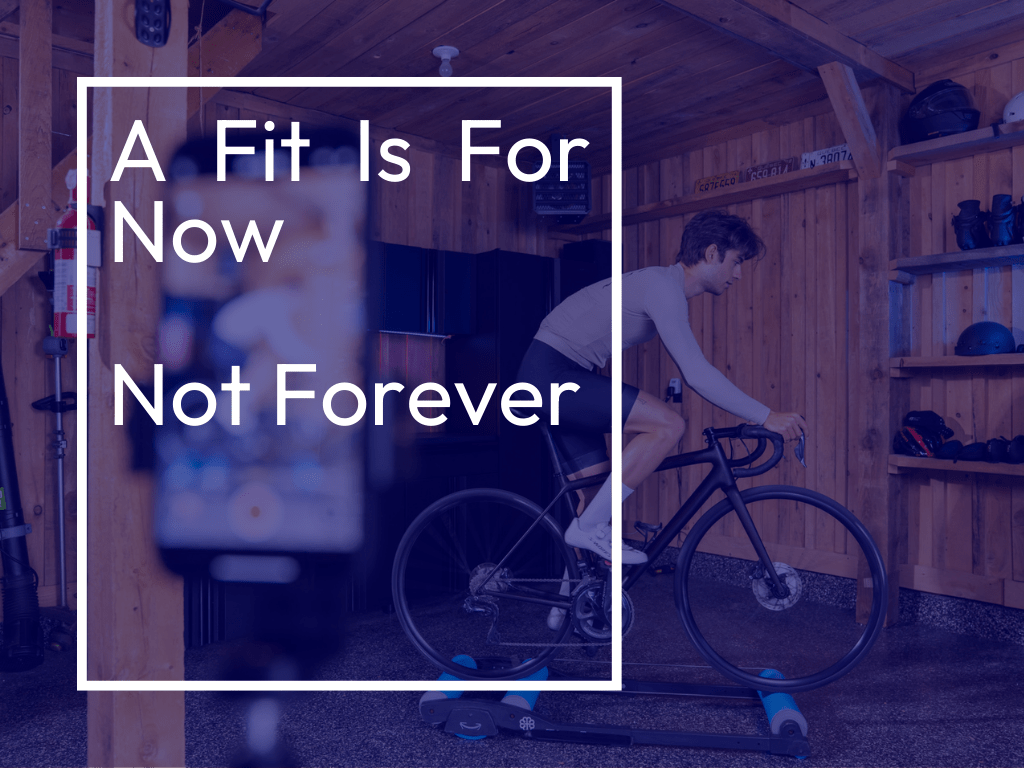
June 30, 2023
A Bike Fit Is For Now, Not Forever
By Justin Goulding
A seasonal bike fit keeps your bike in touch with you as a rider.
You’ve probably been told time and again about the importance of getting a proper bike fit. But what is often not discussed is that a bike fit shouldn’t be a one-time deal, or even just a once every few years kinda thing. Just as our bodies change over time, so too should our riding positions.
In this post, we’ll explore the dynamic nature of a rider’s cycling position and how a bike fit reflects only a snapshot in time. We’ll touch on the potential benefits of making adjustments throughout the year as our bodies change due to fitness and time on and off the bike.
The Fluid Nature of Bike Fits
A bike fit is designed to optimize your comfort and efficiency, while mitigating injuries by aligning your bike with your body’s unique morphology and biomechanics. The ideal fit depends on various factors, including your bike, riding goals, and your physical mobility and strength. These factors, like most things in cycling, are not static. As a result, a bike fit is a reflection of you as a person and cyclist in that moment, not something that is fixed for all time.
If you’d like to learn more about the big picture goals that go into establishing a great fit, check out our post Balancing Goals in Bike Fit.
As you progress as a cyclist (and as a human), your body experiences changes that affect your optimal riding position. Some changes occur over long periods of time (often associated with aging), while others may change day to day. Flexibility, training, riding style, and injuries all play a role in how your body interacts with your bike. Perhaps you’re working on improving your strength and flexibility, or maybe you’re transitioning training focus from criterium racing to gravel events. These changes in your goals and abilities often benefit from adjustments to your riding position to ensure you maintain the best possible comfort and performance.
Aside from changes to our bodies, many riders make changes to their bikes and equipment on a semi-regular basis. Be it a whole new bike, new handlebars, or even new shoes, these all impact how we interact with our bike and are likely to require changes to our fit. Though an oversimplified approach may suggest that simply transferring measurements from one bike to another is sufficient, this often ignores the intricacies of individual pieces of equipment. While these changes don’t often warrant a wholesale change of your riding position, careful consideration of the impacts can do wonders for getting the most from your gear.
The Seasonal Cyclist: Changes Through the Year
The cyclical nature of riding and training often leads to changes in a cyclist’s body throughout the year. Increased mileage and intensity during the peak season generally results in improved fitness, strength and flexibility, while taking time off the bike during the off-season can lead to decreased fitness levels and muscle tightness. The riding positions that are comfortable and sustainable midway through your peak season are often notably different from the ones that feel right coming out of the off season.

For example, you might find that your saddle height needs to be adjusted as your flexibility improves, or that your handlebar height should be changed based on the types of events you’re targeting or the terrain you’re riding. Being aware of these changes and open to making adjustments accordingly can help to maintain optimal performance and prevent potential injuries.
The Benefits of Regular Bike Fit Assessments
Staying on top of your bike fit not only ensures you’re riding in the most comfortable and efficient position but can also help you avoid common overuse injuries associated with improper fit.
Regular assessments can help you:
- Enhance comfort: A proper fit can alleviate pressure points and discomfort, leading to more enjoyable and longer rides. Maintaining an existing position even when it’s no longer comfortable is counterproductive, even if you arrived at that position relatively recently.
- Maximize performance: An optimal bike fit allows you to perform at your best. Depending on your discipline, this can mean generating the most power, maintaining the best aerodynamics, or optimizing your handling. Maximizing your performance is about balancing goals and relies on adapting to changes on an ongoing basis.
- Prevent injury: Adjusting your bike fit to match your current physical state can help minimize stress on joints and muscles, reducing the risk of overuse injuries. While overuse injuries may seem trivial, they often require the longest recovery time.
Wrap-Up
A bike fit is not a one-time static event, it’s an ongoing conversation between rider and bike. It’s essential to embrace this evolving journey and recognize that your riding position is likely to change as you progress and adapt. Regular bike fit assessments and adjustments can help you stay on top of these changes, ensuring optimal performance, comfort, and injury prevention. So, enjoy the ride and embrace the fluid nature of your cycling experience!
Justin is a lifelong cyclist that has spent the past 20 years in the bike industry across a variety of roles. His diverse work in sales, procurement, and instructing is all driven by a desire to help more people experience the wonders of cycling. He brings this breadth of experience to building MyVeloFit into a company and service that not only provides bike fits, but one that enables more people to get the most out of cycling.
-
Justin Gouldinghttps://www.myvelofit.com/fit-academy/author/justin/
-
Justin Gouldinghttps://www.myvelofit.com/fit-academy/author/justin/
-
Justin Gouldinghttps://www.myvelofit.com/fit-academy/author/justin/
-
Justin Gouldinghttps://www.myvelofit.com/fit-academy/author/justin/
Ready to get started?
Athletes from around the world use MyVeloFit to improve their cycling position.
Whether you are a veteran or new to the sport, MyVeloFit can help you improve your position.
More →


